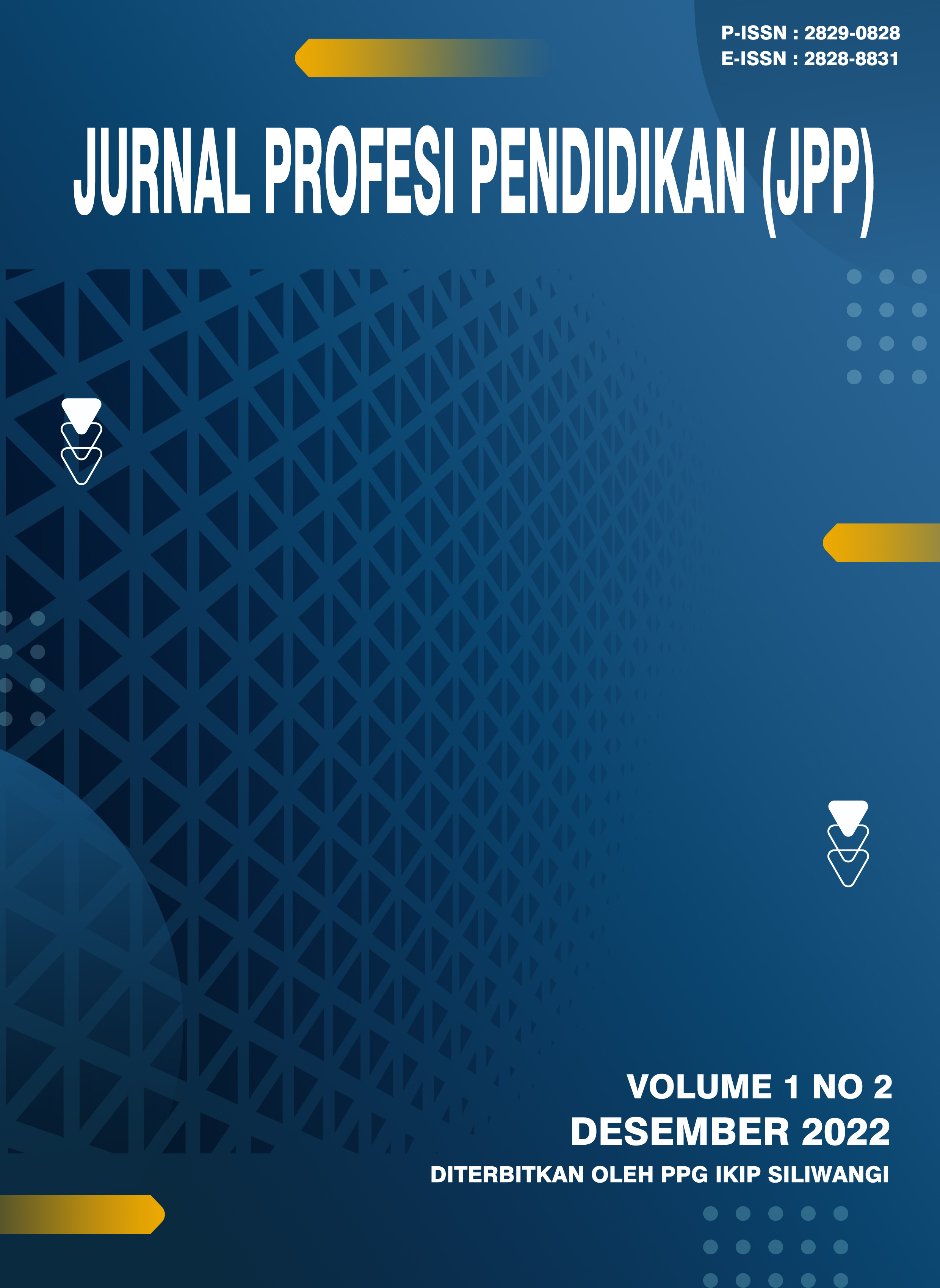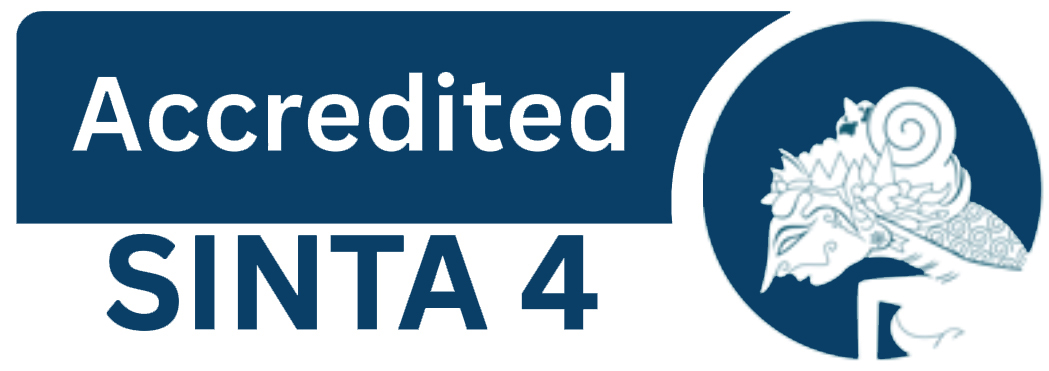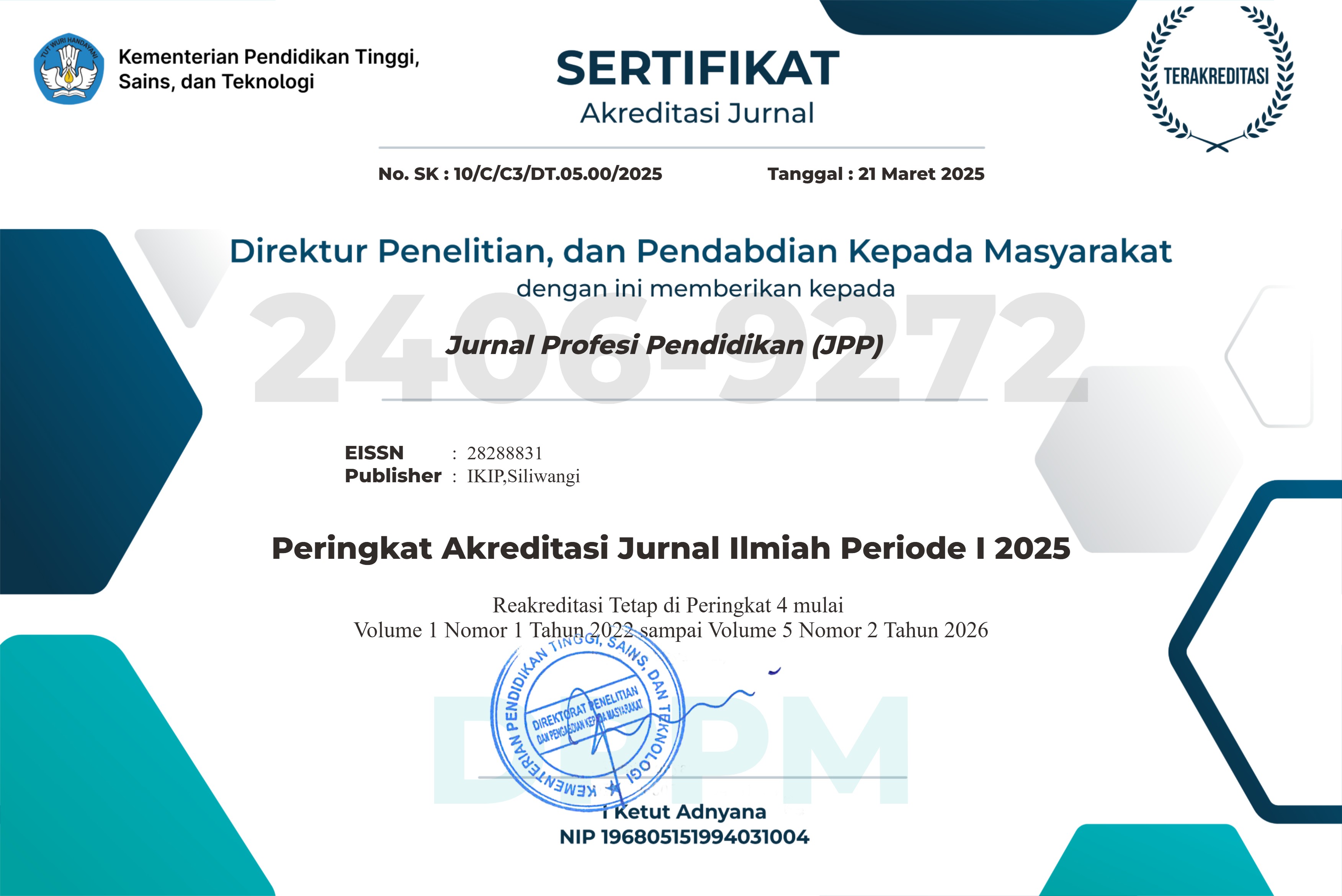Pengembangan Media Roda Berputar (Rotar) Dalam Pembelajaran IPA Kelas V SD Negeri 2 Trikarya
DOI:
https://doi.org/10.22460/jpp.v1i2.10918Keywords:
pengembangan, media roda berputar (rotar), pembelajaran ipaAbstract
Penelitian ini bertujuan untuk mengembangkan media roda berputar (rotar) dalam pembelajaran IPA kelas V SD Negeri 2 Trikarya. Jenis penelitian ini yakni Research and Development dengan model pengembangan 4D. Subjek penelitian ini berjumlah 24 siswa. Teknik pengumpulan data yakni wawancara, angket dan tes. Berdasarkan hasil uji kevalidan diperoleh skor keseluruhan sebesar 0,81 dengan kategori tinggi. Hasil dari uji kepraktisan dengan skor rata-rata keseluruhan 94,21Â dengan kategori sangat praktis. Dan hasil dari uji efektifitas dengan skor rata-rata keseluruhan 0,77 dengan kategori tinggi, sehingga dapat disimpulkan bahwa media roda berputar (rotar) memenuhi kriteria valid, praktis dan efektivitas.
Â
References
Ananda, D., Sari, V. P., Untari, M. F. A. (2018). Keefektifan Model Pembelajaran Make A Match Menggunakan Media Paperku Terhadap Keaktifan Siswa Kelas III SD Negeri 02 Sitemu Pemalang. Jurnal of Primary and Children’s Education, 1, 22–26.
Gusdiana, P,. Egok, A. S,. Firduansyah, D. (2021). Pengembangan Media Kotak Permainan Spinning Wheel Pada Mata Pelajaran IPA Siswa Kelas IV SD Negeri 69 Lubuklinggau. Jurnal Of Elementary School Education, 1, 41–50.
Kelana, J. B., Wardani, D. S., & Wulandari, M. A. (2021). Learning Methods and Critical Thinking Ability on Science Learning Outcomes. Jurnal Ilmiah Sekolah Dasar, 5(1), 69–76. https://doi.org/10.23887/jisd.v5i1.29940
Lestari, F., Egok, A. S., Febriandi, R. (2021). Pengembangan bahan ajar matematika berbasis problem bases learning pada siswa sekolah dasar. Jurnal Basicedu, 37, 27–32.
MZ, Y. (2013). Pengembangan Permainan Ular Tangga Untuk Kuis Mata Pelajaran Sains Sekolah Dasar. Jurnal Teknik, 3, 75–83.
Samatowa, U. (2016). Pembelajaran IPA Di Sekolah Dasar. PT Indeks.
Siregar, L. R., dkk. (2017). Pengembangan Media Pembelajaran Modul Elektronik Mata Kuliah Diagnosis Kendaraan Diprogram Studi Pendidikan Teknik Mesin Universitas Sriwijaya. Jurnal Pendidikan Teknik Mesin, 4, 44–50.
Sugiyono. (2013). Metode Penelitian Pendidikan. ALFABETA, Cv.
Wardani, D. S., Kelana, J. B., & Jojo., Z. M. M. (2021). Communication Skills Profile of Elementary Teacher Education Students in STEM-based Natural Science Online Learning. Profesi Pendidikan Dasar, 8(2), 98-108. https://doi.org/dx.doi.org/10.23917/ppd.v7i1.9652
Downloads
Additional Files
Published
How to Cite
Issue
Section
License
Copyright (c) 2022 Jurnal Profesi Pendidikan (JPP)

This work is licensed under a Creative Commons Attribution-ShareAlike 4.0 International License.
Authors who publish with the Journal Pendidikan Profesi (JPP) agree to the following terms:
- Authors retain copyright and grant the journal the right of first publication with the work simultaneously licensed under a Creative Commons Attribution License (CC BY-SA 4.0) that allows others to share the work with an acknowledgment of the work's authorship and initial publication in this journal.
- Authors are able to enter into separate, additional contractual arrangements for the non-exclusive distribution of the journal's published version of the work (e.g., post it to an institutional repository or publish it in a book), with an acknowledgment of its initial publication in this journal.
- Authors are permitted and encouraged to post their work online (e.g., in institutional repositories or on their website) prior to and during the submission process, as it can lead to productive exchanges, as well as earlier and greater citation of published work. (See The Effect of Open Access)
Similar Articles
- Evie Rahmawati, Latifah Latifah, Pemanfaatan Media Audio Visual dan Quizizz Pada Pembelajaran Daring Surat Pribadi dan Surat Dinas , Jurnal Profesi Pendidikan: Vol. 2 No. 2 (2023): December
- Inthan Nenditha, Jajang Bayu Kelana, Pengembangan Media Pembelajaran Powerpoint Interaktif Untuk Meningkatkan Kemampuan Pemahaman Konsep IPA Siswa Kelas IV SDP Al- Basyariah , Jurnal Profesi Pendidikan: Vol. 2 No. 2 (2023): December
- Ayang Wike Sintia, Jajang Bayu Kelana, Anugrah Ramadhan Firdaus, Peningkatan Keterampilan Berpikir Kritis Pada Mata Pelajaran IPA Materi Rangkaian Listrik Sederhana Dengan Menggunakan Model Pembelajaran STEM di Kelas VI Sekolah Dasar , Jurnal Profesi Pendidikan: Vol. 3 No. 1 (2024): June
- Monica Desy Deria, Duhita Savira Wardani, Pengembangan Media Pembelajaran Powerpoint Interaktif Untuk Meningkatkan Kemampuaan Pemahaman Konsep IPA Siswa Kelas V Sekolah Dasar , Jurnal Profesi Pendidikan: Vol. 1 No. 2 (2022): December
- Febrianti Amini, Jajang Bayu Kelana, Ronny Mugara, Pengembangan Bahan Ajar Materi Interaksi Sosial Berbasis Model Pembelajaran Kooperatif Tipe STAD , Jurnal Profesi Pendidikan: Vol. 3 No. 1 (2024): June
- Husni Qodariah, Sylvia Rabbani, Pengembangan Media Pembelajaran Ayam MSP Materi Satuan Panjang Berbantuan Aplikasi Scratch Dengan Menggunakan Model Discovery Learning Untuk Meningkatkan Pemahaman Konsep Matematika Pada Siswa SD Kelas III , Jurnal Profesi Pendidikan: Vol. 1 No. 2 (2022): December
- Ricke Agsela Tikuasa, Titin Supiani, Lilis Jubaedah, Pengaruh Intensitas Menonton Video Tutorial Hairdo Melalui Media Sosial Tiktok Terhadap Hasil Belajar Penataan Rambut Siswa (Studi Kasus: Siswa Student Day SMA Plus PGRI Cibinong) , Jurnal Profesi Pendidikan: Vol. 2 No. 2 (2023): December
- Asih Martiasari, Jajang Bayu Kelana, Peningkatan Pemahaman Konsep Matematika Menggunakan Model Pembelajaran Problem Based Learning Berbantuan Media Manipulatif Untuk Siswa Sekolah Dasar , Jurnal Profesi Pendidikan: Vol. 1 No. 1 (2022): June
- Ayu Aisyah Fadillah, Asep Sukenda Egok, Novianti Mandasari, Pengembangan Media Bola Hitung Berbasis Montessori Pada Pembelajaran Matematika Materi Penjumlahan dan Pengurangan Kelas II MI Nurul Islam Lubuklinggau , Jurnal Profesi Pendidikan: Vol. 1 No. 2 (2022): December
- Enur Nurmawati, Meningkatkan Motivasi dan Hasil Belajar Matematika Peserta Didik Kelas VII Melalui Penerapan Model Pembelajaran Problem Based Learning , Jurnal Profesi Pendidikan: Vol. 3 No. 1 (2024): June
You may also start an advanced similarity search for this article.

















